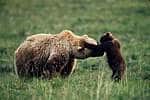 As large carnivores, Alaska brown bears range over great expanses of land, sometimes as much as 150 square miles for a single bear. In addition, brown bears depend upon such land features and associated animals and plants as alpine, slopes, sedge meadows, salmon streams, and old growth forests. These areas satisfy seasonal needs for feeding, winter denning, raising cubs, and other survival activities. Thus, while it is important when studying animals to understand the habitat or particular environment they require to survive, in studying brown bears it is important to understand an entire complex of interrelated habitats or what is called a landscape.
As large carnivores, Alaska brown bears range over great expanses of land, sometimes as much as 150 square miles for a single bear. In addition, brown bears depend upon such land features and associated animals and plants as alpine, slopes, sedge meadows, salmon streams, and old growth forests. These areas satisfy seasonal needs for feeding, winter denning, raising cubs, and other survival activities. Thus, while it is important when studying animals to understand the habitat or particular environment they require to survive, in studying brown bears it is important to understand an entire complex of interrelated habitats or what is called a landscape.
Most of us are familiar with the term ecosystem. The term is used to describe a community of plants and animals functioning together with their nonliving environment . An ecosystem, such as a pond, or a forest is a relatively homogeneous unit, even though it may be very complex. A landscape, on the other hand, encompasses a combination of ecosystems that are closely related and intertwined. It is made up of different ecosystems, such as marshes, meadows, or stream side forests, that function and change in relation to each other.
Landscapes are made up of three basic elements
- Background matrix is the most plentiful of all the elements
- Patches whose composition differs from that of the matrix
- Corridors, narrow strips of land that differ from the matrix on either side of them.
For example, if part of Southeast Alaska were described as a landscape, temperate rain forest would be the matrix. Soggy peat bogs, estuarine meadows, avalanche slopes, and a mining camp would be some of the patches. Salmon spawning streams and an old gravel road to the mine would be two kinds of corridors.
 A habitat is the place an organism inhabits in fulfilling its life needs; food, shelter, and water. To be considered a habitat, an area must be large enough to support a population over a long period of time. For animals such as brown bears, which require a number of integrally related habitats for their activities, it is more accurate to describe the “place they inhabit” with the more expansive term of landscape. Thus, bears are species of landscapes rather than habitat types.
A habitat is the place an organism inhabits in fulfilling its life needs; food, shelter, and water. To be considered a habitat, an area must be large enough to support a population over a long period of time. For animals such as brown bears, which require a number of integrally related habitats for their activities, it is more accurate to describe the “place they inhabit” with the more expansive term of landscape. Thus, bears are species of landscapes rather than habitat types.
If an animal’s habitat is its “address.” its niche is “the way it makes its living.” The term niche refers to the role an organism plays in an ecosystem, or how it functions in the world. An organism’s niche includes physical factors such as its food preferences and requirements for shelter and biological and behavioral factors such as how it acquires its food and how it relates to other organisms.
The concept of niches suggests that similar species with different niches are able to coexist in one ecosystem because they use resources differently. Brown bears and black bears often coexist in parts of Southeast Alaska because they use different resources. Black bears feed and raise their young primarily in forested areas, where they are able to climb trees for protection from people or other animals that may threaten them. The larger, more aggressive brown bears forage and raise their young in alpine and more open areas. Here the brown bears’ aggressive nature and larger size serve as their defense from threats.
Conservation Science Executive Director, Bruce Wright, has worked with bears in Alaska and had many close encounters. He survived those situations by carefully following the suggestions provided below. Be safe in bear country so that both you and bears can live.









